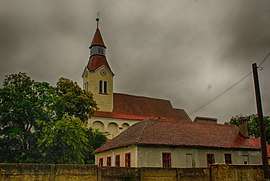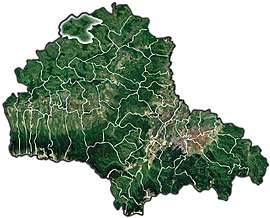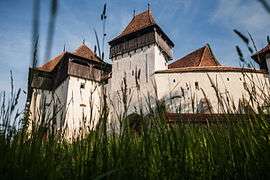Bunești, Brașov
Bunești (German: Bodendorf; Hungarian: Szászbuda) is a commune in Brașov County, Transylvania, Romania. It is composed of five villages: Bunești, Criț, Meșendorf, Roadeș and Viscri. Each of these has a fortified church.
Bunești | |
|---|---|
 | |
 Location within the county | |
 Bunești Location in Romania | |
| Coordinates: 46°3′N 25°6′E | |
| Country | |
| County | Brașov |
| Area | 142.99 km2 (55.21 sq mi) |
| Population (2011)[1] | 2,357 |
| • Density | 16/km2 (43/sq mi) |
| Time zone | EET/EEST (UTC+2/+3) |
| Vehicle reg. | BV |
Villages
| In Romanian | In German | In Hungarian |
|---|---|---|
| Bunești | Bodendorf | Szászbuda |
| Criț | Deutsch-Kreuz | Szászkeresztúr |
| Meșendorf | Meschendorf | Mese |
| Roadeș | Radenthal or Radeln | Rádos |
| Viscri | Deutschweißkirch Weißkirch |
Szászfehéregyháza |
Viscri
Viscri's population is of Roma majority, with a few Romanians, and about 20 Germans. It lies northwest of Rupea and can be reached through Dacia on a 7 km unpaved road. The village is best known for the highly fortified Viscri fortified church, originally built around 1100. It is part of the villages with fortified churches in Transylvania, designated in 1993 as a World Heritage Site by UNESCO. The first documentation of Viscri is a record of church taxes dated around 1400, in which the village is referred to as being part of the Rupea parish. Its inhabitants consisted of 51 farmers, 1 school master, 3 shepherds and 2 paupers.[2]
The origins of the fortified church date from 1100 when the Székelys built a small church with a single hall and semicircular apse. Around 1185 the church was taken over by Saxon colonists, and the Székelys were forced to settle further north. In the 14th century the eastern part of the church was rebuilt and in 1525, the first fortifications with towers were added. In the 18th century the church was surrounded by a second defense wall. After 1743 a covered corridor for the storage of corn was built. A century later, two chambers in the defense corridor of the bastion were turned into school rooms. The classic 19th-century altar has as centerpiece "the Blessing of the Children" by the painter J. Paukratz from Rupea. The font was made from a capital of the 13th-century church. To this day, the church is surrounded by a cemetery with gravestones dating back to the "Bijelo Brdo culture".
In 2006, The Prince of Wales bought and restored two 18th century Saxon houses in the Transylvanian villages of Mălâncrav and Viscri to help protect the unique way of life that has existed for hundreds of years and promote sustainable tourism. The buildings have been sensitively restored and converted into guesthouses for tourists. They remain in keeping with the surrounding architecture and feature a number of Transylvanian antiques but with modern facilities where possible. The renovation of these buildings has helped provide a sustainable future for the people of rural Transylvania while also enabling residents to maintain their traditional way of life.[3]
Gallery
 Front view of Viscri fortified church
Front view of Viscri fortified church Surrounding walls of Viscri fortified church
Surrounding walls of Viscri fortified church- Saxon houses in Viscri
 Orthodox church in Bunești
Orthodox church in Bunești
See also
References
- "Populaţia stabilă pe judeţe, municipii, oraşe şi localităti componenete la RPL_2011" (in Romanian). National Institute of Statistics. Retrieved 4 February 2014.
- "Archived copy". Archived from the original on 2008-10-18. Retrieved 2009-02-07.CS1 maint: archived copy as title (link)
- http://www.princeofwales.gov.uk/newsandgallery/focus/the_prince_of_wales_s_properties_in_romania_1484339285.html
